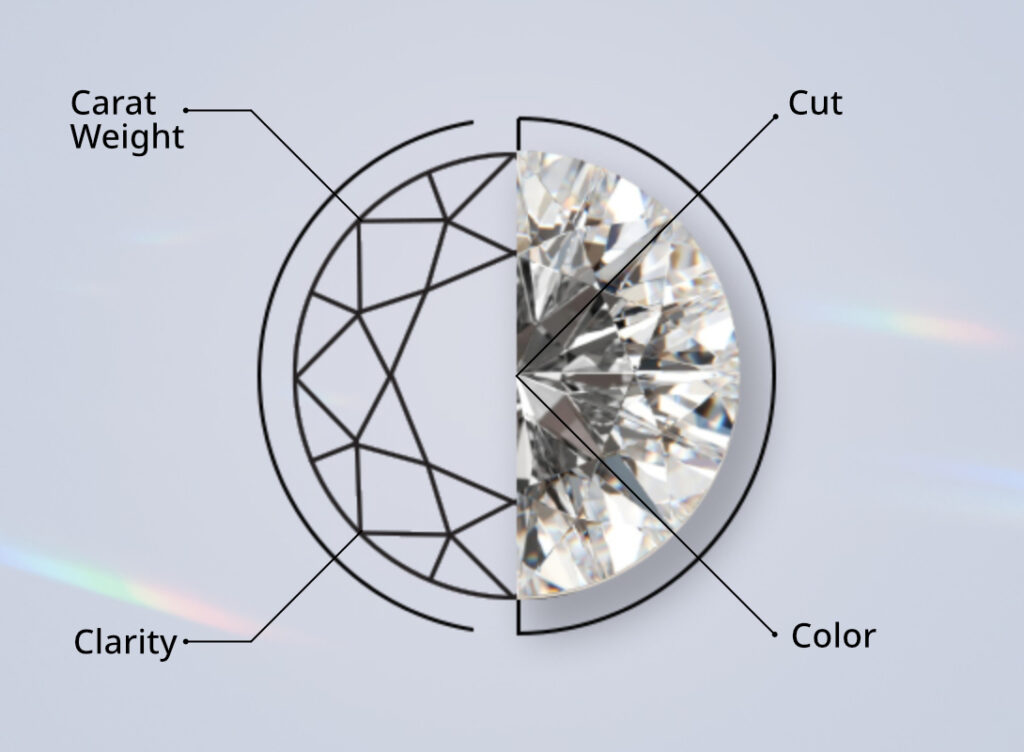In recent years, lab-grown diamonds have gained significant popularity, offering a sustainable and ethical alternative to traditional mined diamonds. These diamonds are chemically, physically, and optically identical to natural diamonds but are created in a controlled environment using advanced technological processes. If you’re considering purchasing a lab-grown diamond, it’s crucial to understand the lab grown diamonds 4Cs – as they are the primary factors determining the value and quality of the diamond.
Understanding the 4Cs of Lab-Grown Diamonds
The 4Cs are the cornerstone of diamond evaluation. These four characteristics help assess a diamond’s quality and, ultimately, its price. When it comes to lab-grown diamonds, the same 4Cs apply as with natural diamonds, ensuring you can make an informed decision when buying. Let’s explore each of these attributes in detail.
The Importance of Cut in Lab-Grown Diamonds
The cut of a lab-grown diamond plays a critical role in its overall appearance. It refers to how well the diamond has been shaped and faceted, which directly impacts how light reflects off the diamond. A well-cut lab-grown diamond will sparkle brilliantly, making it more attractive and valuable. While lab-grown diamonds are created in controlled environments, the cut is still a result of the skill and precision of the professionals who shape it. Therefore, when choosing a lab-grown diamond, ensure you prioritize the cut quality, as it maximizes the diamond’s brilliance and visual appeal.
Color and Lab-Grown Diamonds: What You Need to Know
The color of a diamond refers to the absence of color, with diamonds being graded on a scale from D (colorless) to Z (light yellow or brown). Lab-grown diamonds are graded based on the same color scale as natural diamonds, meaning they can have a wide range of hues. The most sought-after diamonds are those that are near colorless (D-F), as they allow the diamond to reflect light more effectively. Lab-grown diamonds offer the same level of color variety, allowing buyers to find a stone that suits their preferences while maintaining an ethical and sustainable approach to diamond ownership.
Clarity in Lab-Grown Diamonds: What to Expect
The clarity of a lab-grown diamond refers to the presence of internal or external imperfections known as inclusions and blemishes. Lab-grown diamonds are produced under controlled conditions, allowing them to exhibit fewer flaws than man made diamonds. As a result, many lab-grown diamonds are of higher clarity grades, making them an appealing choice for those seeking a near-perfect stone. The clarity scale ranges from Flawless (no inclusions or blemishes visible under 10x magnification) to Included (inclusions and blemishes visible to the naked eye). If you’re looking for a visually flawless lab-grown diamond, you’re likely to find it with relative ease compared to natural diamonds.
Carat Weight and Lab-Grown Diamonds: Size Matters
Carat weight is one of the most well-known aspects of a diamond’s quality. It refers to the weight of the diamond, with one carat equaling 0.2 grams. When it comes to lab-grown diamonds, carat weight is equally important as it influences both the size and value of the diamond. However, because lab-grown diamonds are typically more affordable than their mined counterparts, you may be able to purchase a larger carat weight for the same price. If size is a key consideration in your purchase, a lab-grown diamond offers a significant advantage, allowing you to get more value for your money without compromising on quality.
The Benefits of Choosing Lab-Grown Diamonds Over Mined Diamonds
Lab-grown diamonds have gained recognition not only for their quality but also for their ethical and environmental benefits. Traditional diamond mining has been associated with significant environmental damage and human rights violations in some regions. Lab-grown diamonds, on the other hand, are produced with a minimal environmental footprint, as the process avoids the harmful practices associated with mining. Moreover, because lab-grown diamonds are created in a laboratory setting, you can be confident that your diamond has been produced without exploiting workers or contributing to conflict.
How the 4Cs Affect the Value of Lab-Grown Diamonds
Understanding how the 4Cs apply to lab-grown diamonds is essential for assessing their value. The cut, color, clarity, and carat weight of a lab-grown diamond will determine its price, much like any other diamond. However, lab-grown diamonds tend to be more affordable than mined diamonds of similar quality, providing an opportunity for buyers to select higher-quality diamonds within their budget. By focusing on the 4Cs, you can ensure that you are getting the best possible value for your money when purchasing a lab-grown diamond.
Conclusion: Making an Informed Choice with Lab-Grown Diamonds
In conclusion, lab-grown diamonds offer a fantastic alternative to natural diamonds, especially when considering the 4Cs. By understanding the importance of cut, color, clarity, and carat weight, you can select a lab-grown diamond that fits your preferences and budget. Furthermore, the ethical and environmental advantages make lab-grown diamonds an attractive choice for those looking for a more sustainable option without sacrificing beauty or quality. When purchasing a lab-grown diamond, remember to carefully evaluate each of the 4Cs to ensure you’re making an informed decision that suits your needs.

